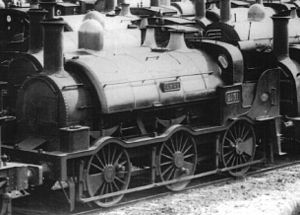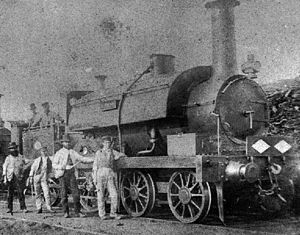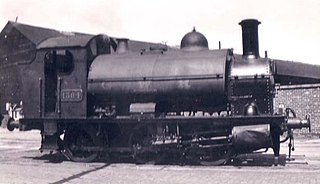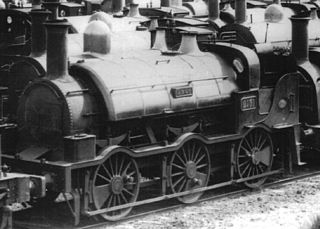
South Devon Railway locomotives were broad gauge locomotives that operated over the South Devon Railway, Cornwall Railway, and West Cornwall Railway in England. They were, at times, operated by contractors on behalf of the railways.

South Devon Railway locomotives were broad gauge locomotives that operated over the South Devon Railway, Cornwall Railway, and West Cornwall Railway in England. They were, at times, operated by contractors on behalf of the railways.
The South Devon Railway was designed by Isambard Kingdom Brunel to be operated by atmospheric power, but this was not a success and so the Great Western Railway provided steam locomotives when the railway first opened. Two High Foundry locomotives were specially named for working on the line, Snake and Viper became Exe and Teign during their sojourn in Devon.
Other locomotives were used including members of the Fire Fly, Leo, and Sun classes, and also Hercules class goods locomotives.
Two tank locomotives, Corsair and Brigand were specially designed by Daniel Gooch with innovative bogies to cope with the sharp curves on the railway. These were known as the Bogie class.
Brunel selected Edward Evans and Charles Geach to supply and operate a new fleet of tank locomotives designed by Gooch. These were supplied by Evans' Haigh Foundry and other builders. Payments were made for working the trains and interest, and various excess charges could also be raised for extra workings. The railway provided engine sheds and were allowed to buy the locomotives at the end of the ten-year contract, which started on 3 June 1851.
A new seven-year contract took effect from 1 July 1859, now signed by Edward Evans, Thomas Walker and Daniel Gooch. The terms were considered to be more beneficial to the railway. The locomotive fleet grew to allow the South Devon Railway to operate a number of independent branches: the South Devon and Tavistock Railway (1859), Dartmouth and Torbay Railway (1859), and the Launceston and South Devon Railway (1865).
A separate contract was signed with the same contractors to provide locomotives to the Cornwall Railway, which had opened on 4 May 1859.
The South Devon Railway bought the locomotives when the contract ended on 1 July 1866 and took over their operation. The Cornwall Railway locomotives were also sold to the South Devon Railway, and further locomotives were provided for the West Cornwall Railway. The locomotives were operated as a common fleet throughout the three railways, but the locomotives were separately accounted for by each railway.
The number of lines operated increased further with the opening of the Moretonhampstead and South Devon Railway (1866), and the Buckfastleigh, Totnes and South Devon Railway (1871). The Lostwithiel and Fowey Railway was also provided with locomotives for a short time when it opened in 1869.
The South Devon Railway was amalgamated into the Great Western Railway on 1 February 1876 and so the whole locomotive fleet was transferred, including those on the Cornwall and West Cornwall railways. They were allocated numbers 2096 to 2179. As the older locomotives were withdrawn they were replaced by more modern locomotives but those for the Cornish fleets continued to be separately accounted for.
The new owners enabled some changes in operation to happen, notably the operation of tender locomotives west of Exeter, such as the well-known Rovers.
The main locomotive workshops were established at Newton Abbot, initially under W. F. Gooch, Daniel's brother, but from 1864 the superintendent was John Wright. Other depots were situated at:
Equipment was provided for some heavier repairs on the Cornwall Railway at Truro and was moved to Falmouth when the line was extended to that town. The West Cornwall Railway had established workshops at Carn Brea which were transferred to the South Devon Railway with their locomotives.



The first Locomotives of the Great Western Railway (GWR) were specified by Isambard Kingdom Brunel but Daniel Gooch was soon appointed as the railway's Locomotive Superintendent. He designed several different 7 ft 1⁄4 in broad gauge types for the growing railway, such as the Firefly and later Iron Duke Class 2-2-2s. In 1864 Gooch was succeeded by Joseph Armstrong who brought his standard gauge experience to the workshops at Swindon. To replace some of the earlier locomotives, he put broad gauge wheels on his standard gauge locomotives and from this time on all locomotives were given numbers, including the broad gauge ones that had previously carried just names.
The Banking Class were five 0-6-0ST Brunel gauge steam locomotives for assisting ("banking") trains up inclines on the Great Western Railway. Designed by Daniel Gooch, they were tank engine versions of his Standard Goods class, and mainly built at Swindon Works.
The Great Western Railway (GWR) Bogie Class 4-4-0ST were broad gauge steam locomotives for passenger train work. The first two locomotives of this class were introduced into service in August/September 1849, with the remainder following between June 1854 and March 1855. All but one were withdrawn between October 1871 and 1873, with the final locomotive being withdrawn in December 1880.
The Great Western Railway Sir Watkin Class were 0-6-0T broad gauge steam locomotives. They were designed for working goods trains through to the underground Metropolitan Railway in London. This class was introduced into service between December 1865 and the last was withdrawn at the end of the GWR broad gauge in May 1892. They were all named after directors and senior officers of the railway.

The 1361 Class were small 0-6-0ST steam locomotives built by the Great Western Railway at their Swindon railway works, England, mainly for shunting in docks and other sidings where track curvature was too tight for large locomotives.

The Cornwall Railway was a 7 ft 1⁄4 in broad gauge railway from Plymouth in Devon to Falmouth in Cornwall, England, built in the second half of the nineteenth century. It was constantly beset with shortage of capital for the construction, and was eventually forced to sell its line to the dominant Great Western Railway.
The West Cornwall Railway was a railway company in Cornwall, Great Britain, formed in 1846 to construct a railway between Penzance and Truro. It purchased the existing Hayle Railway, and improved its main line, and built new sections between Penzance and Hayle, and between Redruth and Truro, and opened throughout in 1852.
The Comet class were 12 4-4-0ST broad gauge locomotives operated on the South Devon Railway and associated railways. They were designed for passenger trains on this steep and sharply curved line but were also used on goods trains when required.
The Eagle class were sixteen 4-4-0ST broad gauge locomotives operated on the South Devon Railway (SDR), Cornwall Railway (CR) and associated adjacent railways. They were designed for passenger trains on this steep and sharply curved line but were also used on goods trains when required.
The Gorgon class were six 4-4-0ST broad gauge locomotives operated on the South Devon Railway, Cornwall Railway and West Cornwall Railway. They were designed for passenger trains on this steep and sharply curved line but were also used on goods trains when required.

The eight Dido class locomotives were 0-6-0ST broad gauge locomotives operated on the South Devon Railway and Cornwall Railway and associated other adjacent railways. They were designed for goods trains but were also used on passenger trains when required.

The South Devon and Tavistock Railway linked Plymouth with Tavistock in Devon; it opened in 1859. It was extended by the Launceston and South Devon Railway to Launceston, in Cornwall in 1865. It was a broad gauge line but from 1876 also carried the standard gauge trains of the London and South Western Railway between Lydford and Plymouth: a third rail was provided, making a mixed gauge. In 1892 the whole line was converted to standard gauge only.
The Torbay and Brixham Railway was a 7 ft broad gauge railway in England which linked the Dartmouth and Torbay Railway at Churston railway station, Devon with the important fishing port of Brixham. It was a little over two miles long. Never more than a local branch line, it closed in 1963.
The nine Vale of Neath Railway 4-4-0ST locomotives were broad gauge 4-4-0ST steam locomotives. The first entered service in 1851 and the last was withdrawn in 1872. The Vale of Neath Railway was amalgamated into the Great Western Railway on 1 February 1865, but the locomotives retained their old numbers.
Vale of Neath Railway 0-6-0ST locomotives were 0-6-0ST steam locomotives for working the heavy goods traffic on the Vale of Neath Railway and its associated lines in Wales. The first of 13 broad gauge locomotives entered service in 1854 and the last was withdrawn in 1886. The remaining four were standard gauge locomotives.
The Carmarthen and Cardigan Railway was a 7 ft 1⁄4 in broad gauge railway line in Wales that was intended to connect Carmarthen on the South Wales Railway with Cardigan. In fact, it was unable to raise the necessary capital and was loss-making from the time of opening the first short section of its line in 1860, and it was in receivership for much of its life. It eventually reached Llandysul in 1864 but was not extended further during its independent existence.

The network of railways in Plymouth, Devon, England, was developed by companies affiliated to two competing railways, the Great Western Railway and the London and South Western Railway. At their height two main lines and three branch lines served 28 stations in the Plymouth area, but today just six stations remain in use.